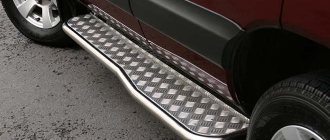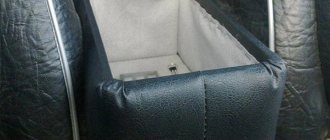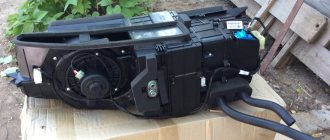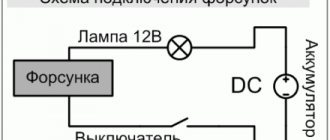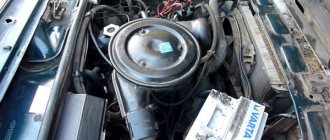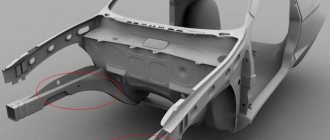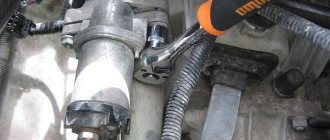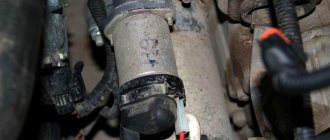One of the owners of Lada Priora decided to do engine tuning by installing a receiver (intake module) from a 1.8-liter VAZ 21179 (from Lada XRAY or Lada Vesta, article number 21177-1008600-00) on the 1.6-liter VAZ 21126 engine. He determined the effectiveness of such modification in several ways.
Why was the receiver from VAZ 21179 chosen?
:
- it is as similar as possible to the VAZ 21126 receiver;
- it is plastic, which means it will not heat the intake air so much, which will have a positive effect on the filling as a whole;
- According to numerous tests, he showed the results of almost TOP receivers.
How to remove the receiver on a Priora
Tools that may come in handy: - 10mm socket; - key 13; - screwdriver.
To remove the intake manifold you will need:
- Due to the fact that in the next steps of the instructions there will be manipulations with electrical wiring, it is necessary to remove the negative terminal of the battery.
- The next step is to remove the plastic screen (cover) from the engine housing. This is done so that it does not interfere with your work.
- After which, it is necessary to remove power from the four ignition coils and dismantle them. To do this, pull out the contact chips. Take a 10mm socket (or a wrench of the same size) and unscrew one fastening bolt on each coil. Simply pull the coils upwards using the necessary force. Now they can be removed. There is no need to remove the spark plugs themselves; they will not interfere with removal. On the other hand, it is advisable to take advantage of the situation and check their condition (gap and spark quality).
- Our next task is to dismantle the throttle assembly. The receiver cannot be removed without removing it. To remove the throttle and avoid excess antifreeze leaking out of the cooling system pipes, you need to prepare first (unscrew the cap of the expansion tank with coolant). To remove the throttle, it is necessary to disconnect all the pipes connected to it, including those responsible for the air supply (corrugation) and cooling. In order to remove the assembly itself, you need to unscrew the two fastening nuts with a wrench or a 13mm socket. Now the assembly together with the sealing strip can be removed, and at the same time inspected and, if necessary, cleaned.
- At this point, locate and remove the crankcase ventilation hose. To do this, loosen the tightened clamp using a flat-head screwdriver and pull it towards you.
- The next step is to dismantle the dipstick structure to check the oil level. It is attached to one screw, which must be unscrewed.
- Now the most important thing is to remove the Priora 16 valve receiver. Doing this is not as difficult as it seems. First of all, we need to unscrew the nuts from the three connecting bolts at the junction of the block and the manifold. It is most convenient to work from a repair pit or using a lift, having previously dismantled the underbody protection of the car. After that, you just have to unscrew two additional nuts.
- It's time to move into the engine compartment and unscrew the two special mounting bolts that are located on the right and left of the receiver housing.
- After which the receiver can be carefully removed.
- Depending on the type and configuration of components in your engine, you may need to unscrew, rotate or remove any component that prevents the receiver from being removed (for example, power steering or a generator).
Lada Priora Sedan › Logbook › Removing the receiver and inserting LPG injectors
Yesterday was a warm February day))) my hands were itching to fix something like that))) And since initially my gas injectors were embedded in a way that was not necessary... /Thanks to my laziness and the advice of experienced installers/, the decision was made... we remove the receiver, and we hit the very “I can’t”... Having studied the hardware, listening to the advice and suffering of subscribers... There are plenty of tools in the garage / I generally bribe them at every opportunity))) /... in short, into battle)))
Dismantling the receiver... 1. Using a 17mm wrench, unscrew the tension roller of the alternator and air conditioner belts /throw off the belt/; 2. Remove the connector from the camshaft position sensor. 3. Using a 13mm wrench (you need two), unscrew the generator mounting nut with one, hold the bolt with the second wrench, then move the generator towards the radiator. The handle of the wheelbrace is ideal for these purposes; the mount did not fit. 4. Remove the connector from the throttle assembly, use a Phillips screwdriver to unscrew the pipe clamp, and use a 10mm wrench /end/ to unscrew the throttle assembly; 5. From the receiver, remove the absorber tube /push-button lock/, the vacuum booster pipe /tightening clamp/ and the thin tube of crankcase gases /tightening clamp/; 6. Using a 10 mm wrench (socket wrench), unscrew the two upper nuts securing the receiver to the “head”; 7. We remove the connectors from all the coils and dismantle the coils of cylinders 1, 2 and 3 /I have them clamped with an asterisk head... a screwdriver for the bits is ideal... without a bit ;)/; 8. Using a Phillips screwdriver, slightly loosen the screw that secures the oil dipstick tube / you need a short screwdriver, a long one won’t fit / and pull out the tube along with the dipstick; 9. Use a Phillips screwdriver to loosen the clamp of the large crankcase gas tube and remove it; 10. Using a 13mm wrench /L-shaped wrench/ we unscrew the outer bolt of the receiver fastening / it sucks to unscrew it, the wrench allows you to make only 1/4 turn of the bolt throughout the entire thread / a cardan adapter would be ideal / I had one, gave it to someone and it disappeared... ))/ or a flexible extension cord;
Pros and cons
The new power drive initially has a number of advantages:
- torque is increased, not only in the high speed range, but also at the bottom;
- oil pump performance has been doubled;
- camshafts are lighter, valve cross-section is increased;
- The displacement and engine power have changed significantly - 1.8 liters and 122 liters. pp., respectively;
- a phase distributor appeared on the intake camshaft;
- the intake and exhaust tracts have been improved, Euro-5 standards have been met;
- it is possible to finalize it to the Euro-6 protocol, planned for 2020.
Phase distributor
Exhaust tract
To replace the timing belt, it is necessary to remove half of the equipment under the hood. We come across defective valves from the German manufacturer Mahle, whose production facilities are actually located in China. Hence the increased oil consumption to 3 l/1000 km, then the cylinder head is replaced, which is very expensive (overhaul instead of maintenance).
Oil pump GMB
The use of high-quality parts from foreign manufacturers is not as clear as the designers intended:
- at any time after the European Union imposes sanctions against the Russian Federation, supplies may stop unilaterally;
- domestic industry is not yet able to provide such manufacturing precision;
- the engines will be equipped with a ShPG, low-quality timing belts and rollers, the service life will immediately decrease by half, that is, to 70 - 80 thousand kilometers.
Automatic tensioner
AvtoVAZ remains practically the only manufacturer in the world that, in principle, cannot provide the necessary precision in the manufacture of parts, which is why selective assembly is used on the assembly line, which indicates not advanced, but extremely poor technologies. It is easier for designers to “force the machine” to distinguish between the accuracy class markings of connecting rods and crankshaft main journals and bearings than to strictly adhere to one accuracy class, as in the entire civilized world.
Crankshaft 21179
Test No. 1
For maximum accuracy, measurements were taken on one day. First on a standard receiver, then it was replaced with a 21179 receiver, and again for tests. The test results are presented in the graph (black - receiver 21126; red - receiver 21179):
Neither Cycle Filling (CN) nor Mass Air Flow (MAF) have changed much. The central cycle has only shifted a little to the top (4500-7000 rpm), and this is logical, because compared to the standard receiver, the channels of the 21179 receiver are slightly shorter (460 mg/c at 4600 rpm and 5200 rpm, respectively ). The owner believes that the low end (XX-2500 rpm) and midrange (2500-4500 rpm) remained the same, both in terms of graph and feel. But at the top the car rides more confidently.
Which receiver is better for Priora?
There is no clear answer to this question. Each situation is individual. However, some comparisons can be made between receivers made of plastic and aluminum.
Advantages of aluminum products:
- higher strength and wear resistance;
- increased engine power due to design features and a larger volume of supplied air;
- Some models are easier to install and therefore easier to remove.
In addition, the shape of the collector itself plays an important role in ensuring increased power, which should not contain sharp corners and transitions. The most important difference between plastic and metal is the strength and durability of the latter. Therefore, we can recommend installing metal types of intake manifolds for Lada Priora cars.
Priora engine tuning 5 ways
In the last article we discussed the advantages and disadvantages of the Priora engine. In this article we will learn about tuning the Priora engine. Let's look at 5 ways. The advantage of the Priora engine is that it has quite good potential for tuning and, if you really want, you can give this engine a power of 300 horsepower. First, we will consider the simplest methods, then we will move on to more complex and costly methods.
Disadvantages of engine 21179
The first 1.8 21179 engines rolled off the assembly line in 2021. Already after 3 years of use, the disadvantages of the “volumetric” motor are known.
The main drawback, according to the owners based on reviews, is the low engine life. What is the reason for this?
- To supply the phase shifter with engine oil, manufacturers drilled additional channels in the cylinder block, thereby calling into question the possibility of boring blocks to unprecedented repair sizes. For comparison, motorsports drivers bore “prioro” blocks 21126 from 82 mm to 84 mm, while civilian engines bore them to 83 mm. Having bored the engine block to dimensions of 83 mm per cylinder, the likelihood of opening the oil channel becomes high.
- Increased load on the crankshaft journal. Compared to the 21126 or 21129 engine, the crankshaft journal was reduced in diameter. Due to the higher piston stroke than on 1.6 engines, we get additional load on the crankshaft.
- The inserts are a calculation error by the engineers. significantly reduce the resource of the internal combustion engine.
- More complex engine maintenance. To change the timing belt, you need special tools, removing the valve cover, etc.
- Oil burn - The connecting rod and piston group from the factory may not be installed in the correct size. (A frequent problem at AvtoVAZ, I encountered it personally). The way out of this situation is to replace the pistons under warranty (the manufacturer assures that the oil consumption will drop as the engine runs in).
- Another nuance is the use of solid oil scraper rings. The use of these rings under load leads to oil consumption. In other matters, like any 16kL VAZ engine, due to the use of these oil scraper rings, oil is consumed at high speeds.
- Knocking of hydraulic compensators - oil starvation, check the oil level
- The cut-off is 6200 rpm - a little not enough for a comfortable volume; you have to switch at the moment the car is directly ahead of you
Engine oil
5W-30 5W-40 10W-40 15W40
Standard oils for VAZ engines. The replacement period is at least once every 10 thousand km. (advice for the benefit of the motor). When asked which oil is best to fill, there are endless battles, tests and correspondence on forums. People evaluate carbon deposits and other parameters that are incomprehensible to “distant” car enthusiasts
The author adheres to his opinion on this matter: it doesn’t matter what kind of oil, the main thing is that it is original from the factory, and not spilled from a barrel in a neighboring garage. Believe me, in practice, finding original oil is not so easy.
Reasons for replacing the Lada Priora receiver
There are a considerable number of varieties of intake manifolds, for example, made from various types of metals or composite materials. However, the Priora receiver is made entirely of plastic. This material prevents excessive heating of the manifold due to a hot car engine.
Thus, the air flow characteristics are improved, which has a positive effect on the proportions and quality of the air-fuel mixture. However, plastic also has a main, negative side - fragility. As a result, numerous breakdowns occur both due to the fault of the car owner and due to low temperatures at which the plastic loses its strength coefficient.
The most common damage can be caused by: - road traffic accidents (even minor ones); — accidental impacts during any repair work in the engine compartment; — other reasons;
If the receiver on your car has through holes or any other leaks, then it must be repaired (if possible) or replaced. If a part is faulty, air loss will occur, resulting in improper engine operation.
What is a receiver for?
In fuel-injected cars, the air travels a long way before entering the combustion chamber. The order of its movement looks like this:
3) Nozzle with mass air flow sensor (MAF).
5) Throttle assembly with damper.
The most important and expensive in this set is the mass air flow sensor. It determines the amount of air that has entered the engine. Based on its readings, the on-board computer regulates the opening time of the injectors, according to the configured setting. This creates an optimal air-fuel mixture. The throttle assembly opens and closes the air flow to increase and decrease rpm. A correctly installed receiver divides the total flow into sleeves, sending identical jets to each of the cylinders.
Why do they change the receiver?
In principle, the receiver is a very durable part. It has no rubbing parts and is not very susceptible to high temperatures or shocks. But still, it is sometimes changed. For two reasons.
Damage can still occur. For example, in the event of an accident, the mounting ears will break due to a strong shock. Or an emergency will occur during removal. Although rare, this does happen. A crack may appear if the fastener loosens on its own. In this case, installation of a new unit is required. Well, the second option is tuning. Many Priora owners dream of raising the power of its engine to “sporting” heights. For this purpose, tuning is used, or as they say, “charging” the engine. There are many operations involved, and one of them is installing a new separator. The fact is that the factory divider is designed for strictly defined volumes recorded in the computer program. And to increase power, you need to increase these volumes. So they install receivers on the Priora with a slightly different configuration.
Main technical characteristics of VAZ engines: 21124,21126,21129,21179 and their comparison
Boring a VAZ-21179 leads to sad results. There are no repair pistons, and an attempt to line the block, due to additional drilling done between the cylinders, for better cooling of the block, is not possible.
Comparison of technical characteristics of VAZ engines: 21124,21126,21129,21179
| Motor name | VAZ-21124 | VAZ-21126 | VAZ-21129 | VAZ-21179 |
| piston stroke | 75.6 | 75.6 | 75.6 | 84 |
| compression ratio | 10.3 | 11 | 10.5 | 10.3 |
| cylinder diameter | 82 | 82 | 82 | 82 |
| number of valves | 16 | 16 | 16 | 16 |
| torque | 131N.m. at 3700rpm | 145N.m. at 4000rpm | 148/4200 | 170/3700 |
| Petrol | 95 | 95 | 92 | 92 |
| Euro | 3 | 4 | 5 | 5 |
| Consumption | 8.9l | 8 | 6.9l | 7.2l |
| Power | 89hp | 98hp | 106hp | 120hp |
| Controller | JANUARY 7.2 | M 7.9.7 or JAN 7.2. | M86 VAZ-21129 Vesta, manual transmission Euro 5 | M86 VAZ-21179 Vesta, AMT |
| Candles | AU17DFMRV | A17DFMRV | BCPR6ES NGK | Q20PR-U11 Denso |
Comparison of engine 21179 with base 21126
The VAZ 21124 engine, unlike 21222, 21126, 21129 and 21179, does not bend the valve; for this purpose there are holes on the bottom of the piston. It can be used with standard shafts or sports ones with moderate lift,
Starting with engine 21126, the piston was reduced, thinner rings were installed, and the connecting rod was lightened. The 21126 engine is already equipped with a new automatic timing belt tensioning mechanism with rollers of a new design.
Many car owners with this engine had their timing belt break and valves and connecting rods bent at very low mileage, due to poor quality pumps assembled at TZA. Pumps or rollers jammed, which led the car owner to significant expenses (from 30 to 50 thousand rubles). At the same time, the belt could easily cover its 150-200 thousand km.
A special two-layer metal cylinder head gasket with a thickness of 0.45 mm was also installed.
At 21179, we increased the working volume to 200 “cubes” and installed a phase shifter at the inlet. Thus, the base 21126 was increased from 98 to 120 horses. Naturally, it was necessary to somehow reduce the thermal load. To do this, it was necessary to make additional cooling channels in the cylinder head, which AvtoVAZ did an excellent job with. 21179 has a new cylinder head with increased fluid flow. But to reduce the temperature in the cylinder block, they did it in a simpler way. The block had the usual oblique drilling between the cylinders. Is the question still open? Will the gasket between the cylinders often burn out due to additional holes?
This practice has already been used on ZMZ engines. When from a 406 engine with 98 hp. made 405,135 hp. We also machined a jumper into the block. The result was disastrous. The cylinder head gasket burned out very often and many drivers began to seal these jumpers with cold welding. So, West drivers from 21179, get ready and stock up on cold welding (just kidding).
Subsequently, ZMZ completely changed the cylinder block and the new engines 405 and 409 already came without a jumper between the cylinders. The plant admitted its mistakes, but more than one thousand gazelle drivers have experienced these factory mistakes. AvtoVAZ cannot yet replace the old cylinder block from 21126 with a new one developed by the designers, due to the too high costs of changing the production cycle. I think in the future they will be forced to replace the unit.
At 21179, the crankshaft was lightened by 40%. Now its stroke will not be 75.6 as it was on 21129, but 84, so the pistons and connecting rods are no longer interchangeable with 21126.
The oil channel plugs on the crankshaft were removed and a neck-to-neck lubrication system was used.
The main bearings do not have a full groove for oil passage, but have a variable profile.
The intake manifold and valve covers are completely plastic.
A rubber gasket was used in the crankshaft damper to dampen torsional vibrations.
There is a new flywheel for the clutch with a diameter of 215 mm, not 220, as was previously the case.
The pump produced by TZA was completely replaced by an imported supplier, apparently Korean.
Europeans make all their engines through one place, and Russian managers, thanks to peripheral capitalism, are good at adopting this experience. When some talkers say that the Russians cannot do anything, this is pure lies and propaganda. We still have great specialists in the automotive industry, but they are caught in the grip of the current economic situation, where it is practically impossible to apply their knowledge and projects. What the USSR did in 1939, the Germans were able to repeat only in the 90s. An example is the V-2 diesel engine with 4 valves per cylinder with two camshafts, which was installed on the T-34 and could even run on sunflower oil. Those designers who then developed an engine that was an order of magnitude superior in its performance to the German engines on the Tiger and Panther tanks need to erect a monument.
Source
What does a receiver for a VAZ 8 valves give?
What is the receiver for?
Is there anyone from Tula in our group:
by Adminrive · Published 04/01/2016
I will buy an amplifier for the subwoofer
by Adminrive · Published 05/12/2017
And we are Nivo fans
by Adminrive · Published 06/22/2015
- Comments 30
- Pingbacks 0
There's Google for questions like this.
air is sucked into the cylinders through it
Sergey, If you install a sports receiver on a stock engine, does it give anything?
Roman, there will be a slight increase in power at high speeds, but at lower speeds the dynamics will be a little worse. It’s better to install everything in the kit and then roll back the firmware
Roman, Sport press gives a shift in power to the high rpm zone... honestly, I’ll tell you that’s all bullshit... the best tuning that can be for your 14. this is a 16 valve) engine... in general it’s cool when there is a wide torque shelf .. if 16 valves are not enough... then shafts + program. and you will be happy 9 seconds to 100 km/h)
Igor, lol. The octopus on the receiver and distributor drives around the stock 126 engine like crazy.
Igor, and a wide shelf in a small space is more of a dream than a reality.
Victor, I have never seen an 8 valve... bypass the 16 valve with res.
Igor, I’m talking about eight-bug on the shaft and STOCK 16kl.
Victor, the stock 16 bypasses the Priora, I can’t imagine what needs to be done with the 8 valve so that it can bypass it, I myself moved from the stock 16 to the 8 with firmware and exhaust
Islam, Fuck, when will you understand that the exhaust is of zero use? Why the fuck are we talking about him on every corner?
Victor, well, the spider is fully equipped with 51 pipes, it drives more vigorously, but I told him that 8 valves will not be able to bypass the gear
Messages: 275 Registered: Mar 03, 2009, 00:00 From: Local Experience: 2004 Car: Honda ACCORD VIII
| Rating: 1 034 |
| Reputation: +5 |
Thanked: 2 times Thanked: 5 times
Posted by jugholley » Oct 18, 2009 5:31 pm
Pasha72, this is the intake!
Added after 7 minutes:
Refinement of the intake system is aimed at reducing air resistance at the intake and increasing the volume of air entering the cylinders. Increases engine power, output and torque.
Messages: 1580 Registered: Jan 13, 2009, 00:00 : Awards: 3
| Rating: 5 580 |
| Reputation: +8 |
Thanked: 8 times Thanked: 64 times
Post by Psion » 18 Oct 2009, 18:12
there will be some advantages. The machine will breathe better.. but I wouldn’t recommend it for stock. not a big arrival. and if there are shafts, a receiver, a large throttle and a nulevik plus competent online firmware, then it will work out on a budget and you can almost say you won’t get into the engine
Added after 1 minute 20 seconds:
Well, then you’ll have to do the exhaust anyway :)
Related links:
The parameters of the intake tract have a huge impact on the nature of the change in power and torque. Due to the most correct determination of the pipeline size and intake settings, it is possible to achieve optimal filling of the cylinders than, for example, by improving the bends of the exhaust system pipeline
It would probably be stupid to completely modernize the exhaust system and completely forget about the intake. After all, the low-resistance filter we installed long before did not completely solve this problem. There is only one conclusion: we changed the exhaust system - we need to modernize the intake - install a sports receiver , otherwise there will be an inconsistency. The car does not breathe deeply, this feeling became aggravated after installing a direct-flow exhaust. It seems that the engine is permanently ill with chronic sinusitis. Nasal drops will not help, you need a high-quality inhaler. The sports receiver was developed and homologated exclusively for sports, and later began to be used on standard devices. Unlike the standard, the “pipes” of the pipes adjacent directly to the “can” have short, large channels that noticeably expand upon entering the huge hollow “cylinder” of the intake manifold. After all, the necessary result of this implantation is an increase in the amount of air supplied to the cylinders. After the throttle, the air enters the receiver, the volume of which significantly exceeds the serial one, and from there it is distributed among the cylinders through enlarged intake pipes of a certain length, which in turn change the direction of air flow by 90 degrees. A larger volume than the standard one makes it possible to smooth out air pulsations (after all, each cylinder is on the intake stroke only once out of four), and also in this geometry, the length of the intake tract is much shorter, which allows you to obtain additional torque at medium and high speeds. The sports receiver significantly improves acceleration dynamics at medium and especially high speeds; with it, up to 7000 rpm, the engine spins up quite quickly and with great pleasure. A standard motor with a factory receiver after 5000 rpm the motor literally “dies” from lack of air. Press - don't press on the accelerator pedal - the result is zero. With the sports receiver installed, it readily responds to the gas pedal pressed to the floor, it “breathes.” The car really drives. It’s not for nothing that doctors prescribe inhalations to sick patients.
Malfunctions, causes, elimination
Since the 21126 engine is a 16-valve front-wheel drive design with an overhead camshaft position, it is prone to characteristic breakdowns:
| No startup when crankshaft rotates | 1) ignition coils are faulty 2) failure of electronic control 3) DPKV breakdown 4)fuel system malfunction | 1) Repair or replacement 2) flashing or replacing controllers 3) replacing the crankshaft position sensor 4) replacing the pressure regulator, cleaning the fuel module, injectors and ramp |
| The engine won't start | 1) cold 2) warmed up | 1) recharging the battery, cleaning the power system, replacing the coolant temperature sensor, replacing injectors, repairing the fuel management system 2) in addition to the above, replacing the air filter |
| The speed is floating XX | 1) vacuum hose connections 2) cylinder head gasket 3) clogged air filter | 1) replacing or tightening clamps 2)use a new gasket 3) cleaning or replacing the cartridge |
| Misfire in XX mode | 1)low compression 2) injector failure 3) failure of the ignition coils 4) faulty spark plugs | 1) replacing rings; valve stem seals2) installation of new injectors 3)repair or replacement 4) gap adjustment or replacement |
If you follow the requirements of the operating instructions and maintenance regulations, these troubles can be avoided.
Priora fuel system
Forced fuel injection, which has already become a classic in the automotive industry, is used on Lada Priora cars. Fuel system composition:
The work is based on the fact that when the ignition is turned on, the electric fuel pump starts working, which builds up pressure in the rail. Further, when the engine is cranked by the starter, the electronic control unit opens and closes the injectors, the air-fuel mixture enters the combustion chambers, according to the operating diagram.
After fuel enters the combustion chamber, a spark is formed between the electrodes of the spark plugs. The fuel ignites and the engine starts. The injectors are electromagnetic valves, and the control unit is responsible for their operation. He is also responsible for the quality of the mixture, the ratio of air and gasoline. Sometimes problems arise and you have to disassemble the fuel system for repairs.
Lada Priora Station wagon with Turbinka › Logbook › Changing the receiver on the Stinger
Finally got around to replacing the standard plastic receiver with a receiver from Stinger. I wanted to not just install a receiver, but take measurements and compare the results. Installation:
Removing the standard receiver went fairly smoothly. I had to remove the generator, but I did this procedure last time and already installed the bottom bolt more conveniently, back to front.
Next, I tried on the new receiver, it didn’t want to stand on the heels, it rested against the generator bracket, so I had to work with an angle grinder.
The Stingera receiver was not equipped with studs for attaching the throttle, but it was not possible to take them from the standard receiver; there was only one stud on it, and the second one was a bolt.
I had to make a stud from a suitable bolt.
I cut the HBO fittings into the free spaces. This time closer to the cylinders, as I was advised.
When I started to pull the receiver into place, I discovered that the outer bolts were too long, they did not attract the edges, their washers rotated freely. I placed additional washers and groovers under them. When I started installing the generator, I discovered that it rested on one of the receiver's horns. There was no desire to remove the receiver again, so I left it like that, the generator is now attached only to the bottom bolt and tightened with a drive belt.
The next problem arose with the air filter housing; with the standard bellows it moved too far back, where there was no room for it at all. I managed to push it upside down and connect it through an old, cut corrugation from the nine.
I couldn't get the oil dipstick into place even by bending the tube. I temporarily plugged the hole with a plug, and in the future I’m going to put a short 8kL probe there. Checking the oil level will now be very inconvenient.
Comparison of results:
I took measurements of the Mass Air Flow and Cyclic Filling on the standard receiver and then on the Stingere. I decided to take not individual peak values, but average values in ranges of 500 rpm, I think this will be more accurate. The measurements were taken on different days, the weather was almost the same, but the position of the air filter housing and its air intake became different, I think this will introduce errors in the measurements.
As you can see, there is an effect from the receiver, but only in the upper range, after 5000 rpm. At medium speeds, it turned out to be a failure. I feel satisfied, the car has become much faster at the top, the traction has become more uniform throughout the entire range (no catch in the middle and no dip at the end).
PS:
Next, I want to do the same measurement at throttle 52, otherwise someone says that it is necessary to install it, someone says that it is of no use. PPS:
I warn you right away that there are no questions about absolute digital values; we are only interested in relative results. But comparing numbers measured on different machines, at different times, with different mass air flow sensors is not correct.
source
Lada 2109 "GARAZHcustoms" › Logbook › Homemade receiver 16 V (cl.) for 2109
Hi all!
I didn’t buy it, I decided to make it myself, because the costs are completely low. So let's get straight to the point. There are a lot of options for receivers for 16 cl engines on VAZs. I wanted a round one, I don’t know why. So I decided to make a receiver for my nine with my own hands. Need a pipe. I used a pipe from Soviet titanium (the one that is used for water in houses).
I'll post the diameter and other dimensions later. I used the legs from the muffler. Muffler inserts would have been a good fit, but I didn’t want to go all the way to Smolensk to get them. They are 12 centimeters long in the photo,
Later they were cut off well when the receiver was installed on the car.
I brought out two tubes from the back. One for the vacuum from the GTZ, and the other for the fuel regulator from the frame. Why is it at the rear and not at the front? It’s more convenient for me and the 4th cylinder runs on the vacuum (it was like that on the carb), so there will be air blowing.
The throttle is installed in the same position as the standard one. The wires reached smoothly. The receiver inlet diameter is 52 mm. ((for now the throttle is standard. In general, so far. Next will be painting work and everything else.
If you have any questions, write.
How to remove and install the receiver
This work is quite accessible to a novice car enthusiast. Read the instructions, prepare the tools and go ahead with the removal and installation. And you need to prepare the following set:
- Driver and extension for heads.
- Heads No. 13, 10.
- Screwdrivers.
- Pliers (just in case).
And you can start working. According to the established tradition of normal locksmiths, the first thing to do is disconnect the battery terminal. And only then start disassembling. The first step is to disconnect all sensors and ignition modules. And move the wire harnesses away from them so as not to damage them. Using a screwdriver, unscrew the clamps on the rubber adapter from the mass air flow sensor to the throttle and remove the adapter sleeve from the damper assembly. Unscrew the two nuts 13 securing the throttle assembly with the Priora receiver.
Using a 10 mm socket, unscrew the bolts securing the ignition modules. Remove them. Unscrew the 2 10mm nuts holding the Priora receiver to the head. Now let's move on to the front. You need to start with the oil dipstick connection. It is screwed with a self-tapping bolt to the receiver. After this, pull the dipstick cover up and put it away. It's time to unscrew the main mounting bolts of the device. There are 5 of them. More precisely, these are 2 13 nuts and 2 bolts. It's quite difficult to unscrew them. Especially if the car is equipped with air conditioning. You will have to use a cardan for the head. But when they are all unscrewed, all that remains is to push the receiver towards you and remove it.
Receiver installation
There's nothing complicated here. Just proceed in the reverse order when installing. The main thing is to check the condition of the rubber O-rings before installation. They are installed directly into the body of the part, around the outlet holes in the head. And on the connection for installing the throttle valve.
Tuning option
Here you need to be very careful. Before choosing a receiver, for example, for the “sports” version, you should definitely consult with a specialist about the firmware and other modifications to the motor.
Useful video on installing a “sports” receiver on a Priora
Conclusion
- Receiver 21179 showed itself better than 21126, as an alternative to the standard one - this is an excellent option.
- Receiver 21179 is not a sports receiver as it is presented in tests.
- The appropriate price for the 21179 receiver is 3,500 rubles (now it is sold for 5,000 rubles).
- With the receiver 21179 the response to pressing the gas pedal has become clearer. When you lightly press the gas pedal, the traction has become better (you can feel the acceleration, there is no need to press the pedal harder as before), the top has become brighter.
Let us remind you that we previously talked about inexpensive tuning of the VAZ 21179 engine, which allows you to increase power by 13%.
Found an error? Select it and press Ctrl+Enter..
VAZ auto parts online store
Subscribe to the newsletter and receive the latest news and promotions from our store.
- Home page
- •
- Articles
Element not found!
Item not found
2007-2019 © 33SPORT - VAZ tuning online store, original VAZ spare parts.
Our address: 445000, Tolyatti, st. Botanicheskaya 11. View on map
You can install the receiver on a Lada Priora car yourself using a drill, liquid welding, a tube and a set of keys. Before installing the receiver on the Priora, you need to select a drill bit for a drill with a diameter of no more than 2-3 mm and a blade for metal. All actions will have to be carried out with the power unit, so first of all it is necessary to remove the air filter, and then dismantle the throttle tubes.
After dismantling, it is necessary to seal the breather neck using cold welding and assemble the entire disassembled structure. It is worth knowing that the installation of the receiver on the Priora is carried out exclusively using cold metal welding, otherwise it will not be possible to secure the elements firmly.
Read also: Electric spray gun for cars
After work, it is necessary to inspect the valve cover and, if necessary, clean it, since sawdust often remains there after using a drill. If you install a receiver on a Priora yourself, then only an air filter with zero resistance is used, and not a standard one. The tubes must be connected from the throttle to the adsorber in the exact sequence.
If there is no adsorber, then the hole will have to be plugged, otherwise a number of troubles will appear. The tube from the crankcase must be connected to the throttle assembly, after which all ties and clamps will need to be tightened well to avoid further problems with the engine.
Previously, sports receivers were developed for sports cars, but after they began to be used on ordinary models, many began to think about installing a receiver on a Priora. As for the receivers installed on the Lada Priora, they have a distinctive feature in the form of huge channels, which, when entering the massive full cylinder of the intake mechanism, can expand greatly.
Thus, installing a receiver on your car allows you to increase the amount of air entering the cylinders. Having passed through the throttle, the air is distributed through tubes into the cylinders, which, by changing the direction of the air, increase the acceleration dynamics at higher speeds.
A regular receiver, after installation, is capable of accelerating the car’s engine to 5 thousand revolutions per minute, but due to the fact that the engine will then not have enough air, it is recommended to use a sports receiver on the Priora.
Birth pangs
The VAZ-21179 engine did not appear out of nowhere. The entire previous history of its emergence is a series of active design work and periods of oblivion. It all started in the early 2000s with plans to create a new model at VAZ, belonging to class “C” - the “Silhouette” project. A heavier car required a more powerful engine.
The existing 16-valve 1.6-liter engines were not suitable for this purpose. It should be said that in the line of VAZ engines there was a power unit with a volume of 1.8 liters. We are talking about unit 2130, which was installed on all-wheel drive vehicles: the five-door Niva and the Nadezhda minivan.
However, it was designed exclusively for “tractor” traction and had a power of only 85 horsepower. Therefore, they began to develop a new engine for the Silhouette project. Then management plans changed, and the developments were archived.
In 2008, they returned to the previous idea again, but they decided not to attempt a completely new unit, but to limit themselves to a deep modernization of the old 1.6-liter due to a lack of funding. One of the planned innovative solutions was the use of a variable valve timing system.
Since VAZ engineers had no experience in this area, it was decided to enter into a contract with the English concern Ricardo, which has the necessary competencies, to carry out calculation and research work. Also, at one time, thanks to cooperation with Porsche, a rather successful engine for the V8 was created, which became the prototype for all subsequent front-wheel drive models.
Work was stopped several times, then resumed again, as VAZ, like the entire Russian economy, was going through difficult times. And suddenly, completely unexpectedly, in March 2016, a new VAZ engine with the index 21179 was put into mass production.
History of origin
Motor 21179 was already in the minds of the engineer much earlier than you can imagine. Even at the end of the USSR, developers began to think about the Lada C project and its power units. Even then, engineers “knew” this motor by its features and power characteristics. But the difficult economic situation of that time and the collapse of the USSR forced the engineers to completely forget the Lada-Ts project.
And now, after a long time, when Boo Anderson comes to the post of general manager of AvtoVAZ, the project is raised and developed again.
The main task was to create an engine with good low-end torque, which AvtoVAZ lacked for a confident, comfortable ride. “Tractor” 8-cl engines have long since become obsolete, but the new 16-cl engines had a more “sporty” character. The situation was corrected by the then 21127 engine, now 21129, which is installed on Vesta, Xray, and other AvtoVAZ models. Due to the intake receiver with variable geometry installed on it, the torque from the bottom began much earlier, unlike the Prioromotor (21126), and its shelf was much further, right up to the cutoff. But with the start of production of a sedan with a larger mass - the Vesta, and the Xray hatchback - the need for low-end engines reappeared.
The engine was run in and tested for a long time. As a result, during the testing process it turned out that the rings were already stuck at 4t.km., as a result, the heat zone was increased and the problem disappeared.
Nissan HR16DE engine with 110 hp power. It copes well with its task on front-wheel drive. But if you have all-wheel drive, it will strain, get hot, eat a lot and not drive.
Another factor in the creation of the 21179 motor is economics and politics. Because the Nissan engine, although it is assembled here, still belongs to Nissan. And in the event of an unfavorable economic situation, an increase in exchange rates, the cost of its production and sale may simply be unprofitable.
Start of production of motor 21179
Back in 2014, there were rumors about the possible production of a 1.8 liter engine with phase shifters. And yet it became a reality. Previously, OPP and its subsidiary Super-Auto were already engaged in the construction and installation of a 1.8 liter engine with index 21128, which was installed in Priora Sport. But that engine did not have a special resource.
History of origin
Motor 21179 was already in the minds of the engineer much earlier than you can imagine. Even at the end of the USSR, developers began to think about the Lada C project and its power units. Even then, engineers “knew” this motor by its features and power characteristics. But the difficult economic situation of that time and the collapse of the USSR forced the engineers to completely forget the Lada-Ts project.
And now, after a long time, when Boo Anderson comes to the post of general manager of AvtoVAZ, the project is raised and developed again.
The main task was to create an engine with good low-end torque, which AvtoVAZ lacked for a confident, comfortable ride. “Tractor” 8-cl engines have long since become obsolete, but the new 16-cl engines had a more “sporty” character. The situation was corrected by the then 21127 engine, now 21129, which is installed on Vesta, Xray, and other AvtoVAZ models. Due to the intake receiver with variable geometry installed on it, the torque from the bottom began much earlier, unlike the Prioromotor (21126), and its shelf was much further, right up to the cutoff. But with the start of production of a sedan with a larger mass - the Vesta, and the Xray hatchback - the need for low-end engines reappeared.
The engine was run in and tested for a long time. As a result, during the testing process it turned out that the rings were already stuck at 4t.km., as a result, the heat zone was increased and the problem disappeared.
Nissan HR16DE engine with 110 hp power. It copes well with its task on front-wheel drive. But if you have all-wheel drive, it will strain, get hot, eat a lot and not drive.
Another factor in the creation of the 21179 motor is economics and politics. Because the Nissan engine, although it is assembled here, still belongs to Nissan. And in the event of an unfavorable economic situation, an increase in exchange rates, the cost of its production and sale may simply be unprofitable.
Start of production of motor 21179
Back in 2014, there were rumors about the possible production of a 1.8 liter engine with phase shifters. And yet it became a reality. Previously, OPP and its subsidiary Super-Auto were already engaged in the construction and installation of a 1.8 liter engine with index 21128, which was installed in Priora Sport. But that engine did not have a special resource.
receiver with or without pipes
#1 StaZ
- Users
- 400 messages
- City: Moscow Yuzhnoe Butovo
- Auto: 2114
I’m thinking of installing a receiver, tell me what is better to take with or without pipes?
The receiver in this case is considered a bragin round P with a stock motor except for the shaft 11 2 and throttle 52
It’s very interesting to know your reasoning and explanations of what the difference is
installation 16v questions in PM lowest prices.
suspension, any spare parts
twisting of runs Samara euro Samara high panel Priora Kalina
- Top
#2 ADAl
- City: Prague, Red Mayak, Chertanovo
- Car: Mitsuban ass carrier
- Top
#3 Corn
- Moscow city
- Interests: rally
- Car: 2108 rally 1600N
- Top
#4 Snippy
- City: Moscow
- Auto: 2115
- Top
#5 StaZ
- City: Moscow Yuzhnoe Butovo
- Auto: 2114
That's what I'm excited about new! It turns out that a well-polished one without a pipe will be suitable for further modification of the engine, unlike pipes that will need to be shortened or lengthened
Post edited by StaZ: 01 April 2009 - 11:54
installation 16v questions in PM lowest prices.
suspension, any spare parts
twisting of runs Samara euro Samara high panel Priora Kalina
- Top
#6 StaZ
- City: Moscow Yuzhnoe Butovo
- Auto: 2114
installation 16v questions in PM lowest prices.
suspension, any spare parts
twisting of runs Samara euro Samara high panel Priora Kalina
- Top
#7 STL
- City: Krasnodar-Moscow, STL-Tuning
- Interests: various
- Car: Mazda 323F V6, VAZ 21061
- Top
#8 StaZ
- City: Moscow Yuzhnoe Butovo
- Auto: 2114
installation 16v questions in PM lowest prices.
suspension, any spare parts
twisting of runs Samara euro Samara high panel Priora Kalina
- Top
#9 ][unter
- City: Russia, Ryazan
- Auto: 2112
mm. Well look. depending on what your plans are with the car(?). Now you spend 10 grand on a receiver, you will gain 5-7 hp. in a month it won't be enough. and you will want to add 8 valves. my advice. It’s better to set aside 10 pieces for the transition to 16V.
GC
- Throttle valve - without mechanical drive.
- Additional oil channels are made in the cylinder head for the phase regulator. Lightweight valves are from Mahle.
- The catcollector is supplied by the Russian company Ecoalliance. The diameter of the input channels has been increased to 39 mm. The oxygen sensor bears the Bosch emblem.
- The crankshaft has an increased crank radius.
- The working volume of the cylinders has increased due to the larger piston stroke.
- A reliable high-performance water pump is purchased from the Korean company GMB.
- For the first time, a VAZ engine has an imported GMB oil pump with increased performance.
- A new automatic timing belt tensioner was used - with two rollers, from the German company INA.
- Lightweight connecting rod and piston group - manufactured by Federal Mogul.
- The fuel rail is from Continental. The injectors have increased productivity, the spray pattern is optimized for the working process of the new engine.
The 1.8 liter engine is not very different in appearance from the current VAZ sixteen-valve engines. But this is a new motor, and of our own design. Main parameters:
- working volume - 1774 cm³
- power - 122 hp
- torque - 170 Nm at 3750 rpm.
The new motor is designed for Vesta, XRAY and Largus models. There is an additional area on the cylinder block for applying the serial number. It is clearly visible when the power unit is installed longitudinally in the engine compartment. Got the hint? There is no official information yet, but it is easy to guess that we are talking about Niva. The cylinder block is unified with that used on the current 1.6-liter VAZ-21126, -21127 and -21129 engines. Same height and same diameter of the cylinders. The differences are in the additional channels of the lubrication system, which ensure the operation of the phase regulator, and additional channels of the cooling system.
What kind of engines will be under the hood of the Lada Vesta and technical characteristics of the units
The power line of five-door domestic cars consists of four-cylinder light-fuel internal combustion engines with a volume of 1.6 and 1.8 liters.
Motor VAZ-21127
Finding out what engine is in the Lada Vesta is easy. For example, the unit under the symbol VAZ-21127 is already familiar to our motorists:
- Power – 106 hp.
- Optimal power speed is 5,800 rpm.
- Torque – 148 Nm.
- Maximum torque speed – 4,200 rpm.
The former “Prior” engine was modernized, a controlled air intake system appeared. Its essence lies in a new receiver, where there are controlled dampers that are responsible for its volume when the engine speed changes. The elasticity of its operation is ensured by the fact that at low speeds air enters it through a long channel, and at high speeds through a short channel.
Car owners operating this unit pay attention to the fact that the timing belt requires special attention and timely replacement. To be fair, it is worth noting that there are no problems with floating speed due to the installation of temperature and air pressure sensors instead of the air mass flow controller
Motor VAZ-21179
To begin with, it must be said that the new VAZ development is a modernization of the above-described engine with index 21127. The project itself was worked out in detail a long time ago, but the concern’s management did not support it at the first stage. Nevertheless, its mass production started in 2016.
In terms of power and technical characteristics, the new Lada Vesta engines exceed their basic version:
- Performance – 122 hp.
- Torque – 170 Nm at 3750 rpm.
- Average fuel consumption is 6.8 liters per 100 km.
- Compression ratio – 10.3.
Only at first glance there is nothing interesting in the new product. Even a novice tuner who has just installed a 4-2-1 spider or a window closer thinks so. Therefore, it is worth focusing on the main stages of modernization.
Lada Priora Hatchback Button › Logbook › Installing the NFR-Style receiver from Stinger
Last Thursday I was in Krasnodar on business. Well, the idea arose to stop by a local tuning parts store. I wanted to take a 4-2-1 spider on a triangular flange from a stinger. Otherwise the resonator just lies there, short and restless. In general, I went for the exhaust and ended up buying the intake. I don’t know what came over me, but the devil pulled me to buy a receiver.
Well, okay, after all, I’m an accomplished adult man and I have the right to petty children’s whims.
